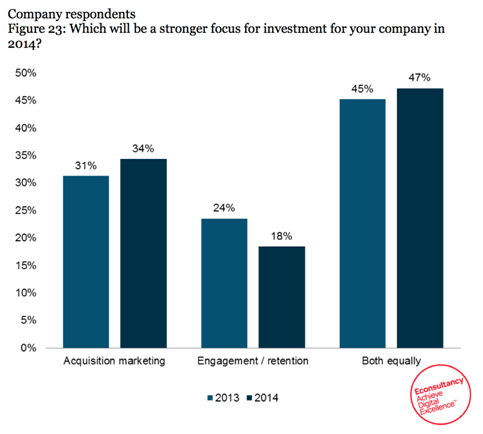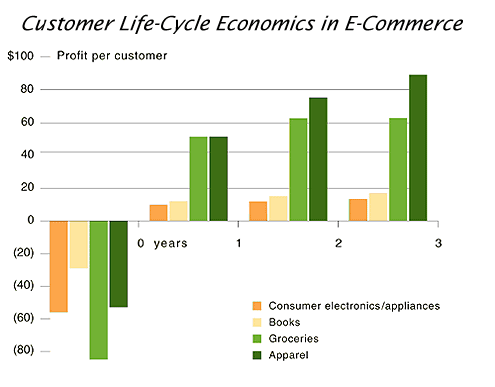
Acquisition vs. retention: Finding the right balance for your store
Of all the questions you face as an online merchant, one of the toughest to answer is how to spend your marketing budget. Where should you allocate your dollars so that they have the most impact? Do you pour them into attracting new customers, or do you focus your efforts on retaining the ones you already have?
It’s a dilemma companies have grappled with for years, and it’s one that’s taken on a new dimension with the rise of growth hacking and overnight startup success. Gaining a bunch of new customers may appear more glamorous than keeping existing customers engaged, but is it more important? What ever happened to quality over quantity?
Today we’re diving deep into acquisition and retention marketing. We’ll look at both approaches, examine some recent ecommerce trends, and try to help you find the right balance for your store. To kick things off, let’s start with an analogy from our friends at Shopify...
Your business as a sports team
Most team sports involve offense and defense. Offensive players are the ones running the plays, attacking the opposing team's territory, and trying to score points, goals and touchdowns. Defensive players are the ones hanging back in their own zone, protecting the goal, and trying to prevent their opponents from scoring.
Running an ecommerce business isn't so different. Your offense is focused on attracting new customers to your store and convincing them to make a purchase, while your defense is all about nurturing relationships with existing customers and keeping them from defecting to one of your competitors. No business can succeed without both, and yet many end up prioritizing one at the expense of the other.
Obsessing over customer acquisition
Most companies say they value their long-time customers, but all the exclusive first-time offers dangled in front of new buyers tell a different story. When was the last time your internet provider offered you a discount for five years of bill payments? Or your credit card awarded you 10,000 bonus points for religiously putting all your purchases on plastic?
According to a 2014 eConsultancy survey, 34 percent of company respondents indicated that they were planning on increasing their investment in acquisition, while only 18 percent said they would focus on retention (the other 48 percent said they would invest in both equally). In another survey, a whopping 63 percent of marketers rated customer acquisition as the single most important advertising goal.

Source: Econsultancy
So why is it that in marketing, just like sports, the offense gets all the glory? According to a white paper by lead management company Performark, one reason is our emotional attachment to the process of acquiring new customers: “It makes us feel like we’re really doing something. On the other hand, focusing our attention on building customer relationships often makes us feel like we’re doing less—even though we’re usually accomplishing more.”
There’s also a common perception that a marketing strategy focused on customer retention doesn’t offer sufficient growth potential. While that may be true for companies just starting out, data from RJMetrics shows that revenues from new and repeat customers converge around year two, and for the most successful companies, repeat revenue only escalates from there. As RJMetrics writes:
"This is potentially the most significant signal of the ability for these companies to become lasting commerce powerhouses. Building a brand that inspires loyalty is the ultimate secret to scale.”
Shifting the balance
Over the past couple of years, companies have finally started to increase their investment in retention marketing—or at least recognize its value. This has a lot to do with consumer choice reaching an all-time high, while attention spans drop to goldfish levels. Overwhelmed by choice and distracted by just about anything, customers are demanding more personalized shopping experiences. This means companies are being forced to put their money where their mouths are when it comes to preserving customer relationships.
But the recent pivot to retention-driven marketing isn’t just the latest trend in an industry dominated by them.
Twenty-five years ago, Bain & Company and the Harvard Business School conducted a study that analyzed the costs and revenues derived from serving customers over their lifetimes. In industry after industry, the study found the same pattern of early losses followed by rising profits as the cost of serving loyal customers diminished and the volume of their purchases rose. “The bottom line: increasing customer retention rates by 5 percent increases profits by 25 to 95 percent.”
When the study was repeated more than a decade later with a focus on ecommerce, researchers found that the pattern was actually exaggerated online. In apparel “e-tail” they found that new customers cost 20 to 40 percent more to acquire than in traditional retail, meaning the losses incurred by these businesses in the early stages were greater. However, in subsequent years, initial losses were more than made up for as profits accelerated.
Their research findings are summarized in this table:

Since that study, several others have published similar findings about the profitability of retention marketing. One study found that the probability of selling to an existing customer is up to 14 times higher than that of selling to a new one. And yet, despite this research, there’s still a strong contingent of established businesses who prefer to accept high churn rates and be forever replacing their customers—madness!
Finding the right balance for your store
With all the evidence presented so far, the message should seem pretty clear: customer retention is important, especially in ecommerce, and especially right now. But it’s not the only thing you should focus on. After all, you’re never going to turn a profit if no one visits your store. And although customer retention should be a priority for almost any established business, some attrition is inevitable, and you should never adopt a completely one-sided approach.
According to Alex McEachern, a Loyalty Marketing Specialist at Sweet Tooth, there are two major things to consider when deciding where to invest your marketing dollars: where your store is in its lifecycle, and what you’re selling. McEachern writes: “At the start of a store’s life, it is vital to attract as many people to the store as possible. If you don’t have any customers you can’t sell to anyone. However, as a store grows, its existing customer base becomes more and more valuable.”
As your business matures, your focus should gradually shift away from acquisition and toward retention. Here’s a look at how your "acquisition vs. retention" spend might evolve over time.

As far as what you're selling, just as there's no single marketing approach to fit a store that opened yesterday and one that’s been in business for years, neither should the same strategy be applied to a store that sells furniture and one that sells pet supplies.
Generally, stores that sell products with high purchase frequencies and high item values have more to gain from a retention-focused strategy than stores that sell products with low purchase frequencies and low values. To see whether your store might be more suited to an acquisition or a retention strategy, you can plot your products on the chart below—just remember that no matter where your products fall, balance is key, and you should never ignore one side completely.
